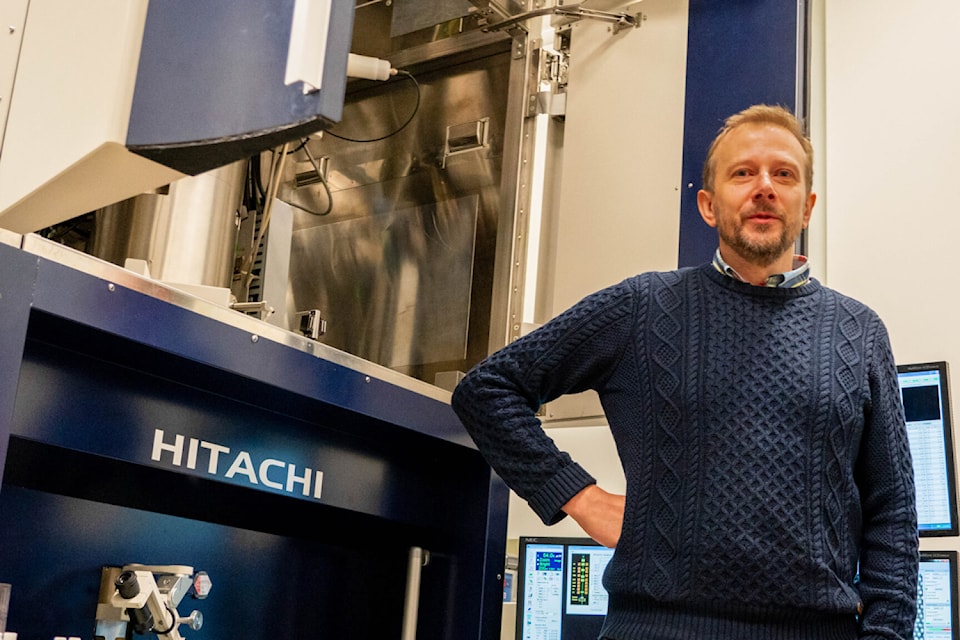Science
University of Victoria Breakthrough Revolutionizes Microscopic Imaging

Researchers at the University of Victoria have achieved a significant breakthrough in electron microscopy, paving the way for enhanced visualization of atomic-scale structures with less expensive and energy-efficient technology. Led by Arthur Blackburn, co-director of the university’s Advanced Microscopy Facility, the team developed a novel imaging technique that allows for sub-Ångström resolution—less than one ten-billionth of a meter—using a compact scanning electron microscope (SEM). This advancement represents a departure from traditional high-cost, large-scale transmission electron microscopes (TEM), which have dominated the field.
In their study published in Nature Communications, the team demonstrated that high-resolution imaging can be achieved without reliance on complex and costly equipment. Blackburn, who holds the Hitachi High-Tech Canada Research Chair in Advanced Electron Microscopy, emphasized the implications of their findings: “We’ve demonstrated that a relatively simple SEM, when paired with advanced computational techniques, can achieve a resolution that rivals or even surpasses traditional methods.”
The newly developed technique employs overlapping patterns of scattered electrons to construct highly detailed images of samples. By utilizing a low-energy beam on the SEM, the researchers reached an impressive resolution of just 0.67 Ångström, which is smaller than the size of an atom and about one-tenth the width of a human hair. This achievement could make advanced microscopy more accessible to laboratories worldwide, significantly lowering the barriers associated with high-resolution imaging.
Impact on Various Fields
The implications of this technological advancement extend across multiple scientific disciplines. Blackburn noted that this innovation could be transformative for areas such as materials science, nanotechnology, and structural biology. In particular, it holds promise for the research and production of 2D materials, which are crucial for the development of next-generation electronics.
Long-term, the technique could assist in elucidating the structures of small proteins, potentially leading to breakthroughs in health and disease research. The ability to visualize atomic-scale structures with lower costs and fewer resources is expected to foster a new wave of research initiatives, particularly in institutions that may have previously faced limitations in their microscopy capabilities.
As this technique gains traction, it may redefine how scientists approach atomic imaging, making it easier for researchers to investigate the fundamental building blocks of materials and biological systems. The University of Victoria’s achievement is a notable milestone in the pursuit of more accessible scientific tools that can drive innovation and discovery across the globe.
-

 Science3 months ago
Science3 months agoToyoake City Proposes Daily Two-Hour Smartphone Use Limit
-

 Health4 months ago
Health4 months agoB.C. Review Reveals Urgent Need for Rare-Disease Drug Reforms
-

 Top Stories4 months ago
Top Stories4 months agoPedestrian Fatally Injured in Esquimalt Collision on August 14
-

 Technology3 months ago
Technology3 months agoDark Adventure Game “Bye Sweet Carole” Set for October Release
-

 World3 months ago
World3 months agoJimmy Lai’s Defense Challenges Charges Under National Security Law
-

 Lifestyle4 months ago
Lifestyle4 months agoVictoria’s Pop-Up Shop Shines Light on B.C.’s Wolf Cull
-

 Technology3 months ago
Technology3 months agoKonami Revives Iconic Metal Gear Solid Delta Ahead of Release
-

 Technology3 months ago
Technology3 months agoApple Expands Self-Service Repair Program to Canada
-

 Technology3 months ago
Technology3 months agoSnapmaker U1 Color 3D Printer Redefines Speed and Sustainability
-

 Technology3 months ago
Technology3 months agoAION Folding Knife: Redefining EDC Design with Premium Materials
-

 Technology4 months ago
Technology4 months agoSolve Today’s Wordle Challenge: Hints and Answer for August 19
-

 Business4 months ago
Business4 months agoGordon Murray Automotive Unveils S1 LM and Le Mans GTR at Monterey









